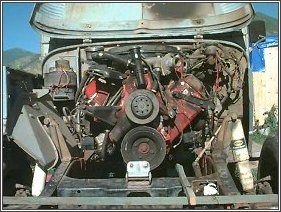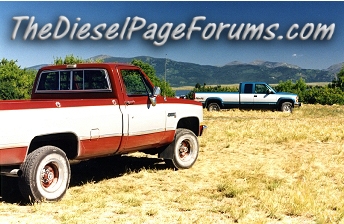FJ Land Cruiser
6.2L Diesel Conversion
A work in Progress
________________________________________
By Aaron Leach - First published by The Diesel Page in 1997
________________________________________
Plenty of power, and great fuel mileage, that’s everyone’s dream when thinking about an engine to be used in special project. At least, that’s what I was thinking about. I looked at the Chevy 350 because this engine is the most popular conversion in the FJ Land Cruiser, but it doesn’t do that well in fuel mileage. Eventually, talked turned to the 6.2L diesel engine. This engine would provide more than adequate power, and deliver excellent fuel economy. But, would this engine fit into my FJ40 Land Cruiser?
After talking to a few mechanics, I found that the 6.2L and the small block Chevy share the same mounts. They also share the same bell housing bolt pattern. Which means, I could use any Chevrolet or GMC transmission and use any conversion kit available for the small block Chevy. All this information led me to install a 6.2L in my Land Cruiser.
Getting Your Engine:
The first thing to do is acquire an engine. When looking for a 6.2L, try to get one that has everything on it: brackets, flexplate or flywheel, torque converter, air cleaner, starter supports, fan, etc. Even though the 6.2L shares some commonality with the small block Chevy, it does not share everything. The more accessory components you get with the engine, the better off you will be, plus it’ll save you a lot of time and money.
If you’re looking to buy a used “running” engine, check the oil pressure and check for excessive amounts of either white or black smoke. Abnormal amounts of either white or black smoke could indicate a problem with the injection system. Most used engines will leak a little oil, but you should specifically check the rear main seal for excessive leaks. Most leaks aren’t too expensive to repair and the best time to take care of the problem is before you install it in your Land Cruiser. Look at the water pump for evidence of coolant seeping past the front seal. The water pump and the injection pump are a couple of the more time consuming items to replace on the engine because of location. These components are more involved to R&R because other engine components need to be removed just to get to them. Having an experienced GM diesel owner along when looking at a used engine will help determine if the one you’re looking at runs normally.
The above is a shot of the engine bay. There is just enough room to clear on both sides.
Conversion Details: I bought the Chevy engine mounting kit and THM350 transmission kit for the Toyota three speed transfer case from Advanced Adapters. I made all the modifications to the transmission and t-case required in the instructions, and then bolted it all up to the engine. I then began the process of fitting the engine to the FJ chassis. I used the same directions that comes in the kit for the 350 small block. I positioned the 6.2 so it was about three inches from the radiator, and adjusted the center-line of the engine at about 12 inches from the left inside frame rail. This measurement was the same as for the small block Chevy engine. One thing to remember is that the 6.2L is physically larger than the 350. I had to remove the stock steering box to make room for the engine. This didn’t affect my plans since I had planned to install Saginaw steering assembly anyway. Because of the width of the engine, I lengthened the steering shaft an extra eighteen inches. This extra length in addition to the installation of a u-joint on the end of the shaft helped ensure the steering components would clear the exhaust manifold. I also removed a few unnecessary components like the cruise control mechanism, and the part of the air inlet system. These mods allowed the stock hood to close properly. The 6.2 engine mounts use a spacer between the engine mount and the block. This spacer is needed for installation.
Here, you might be able to see that I cut the engine mount down so the steering shaft would clear the exhaust manifold.
What You Can Use, and What You Can't:
- The 6.2L engine will accept all GMC & Chevy transmissions: TH350, TH400, 700R4, SM420, SM465, etc.
- A diesel torque converter will perform better at the low rpm range of a diesel engine.
- The 6.2/6.5 flexplates are balanced. A gas flexplate won't work. Also, when using a flex plate, be aware that there are two types. One is made for the THM400 and the other the THM700R4. The 700R4 flexplate works with the TH350 transmission.
- The stock steering on the FJ40 won't clear the engine. You will have to install a Saginaw steering system due to the width of the 6.2.
- The injection pump and injectors use a fuel return system. You will need to run a return line to the fuel tank.
- The 6.2 uses a diesel starter. A gas 350 starter isn’t powerful enough.
- Diesels use their own engine cooling fan.
- One battery will probably fit in the engine compartment, but two might be difficult. The best place to locate a second battery would be behind the seat.
- When installing the 6.2L, make sure that you use the eighth inch spacer between the engine mount and the block. This helps in the fit up process.
- A suspension lift will ease installation because the drive line might hit the oil pan. Also, you may need to experiment with a smaller diameter front drive line.
- The length of the engine/transmission/transfer case assembly necessitates a rather short rear driveline. My rear drive line will only be about twelve inches long. The TH400 and the 700R4 are about 1/2 and 2-1/2 inches longer respectively than the TH350. When you couple a 700R4 to a three speed t-case, the combination increases the transmission/transfer case length a few inches longer than if you were to use a TH350 due to the adapter configuration. The same problem applies when using the TH400 as well.
- A diesel fuel filter/water separator assembly is required.
- Typical 6.2 rpm operating range is between 1500 and 3000 rpm and the best fuel economy will occur at 1800-2000 rpm. An over drive transmission or larger diameter tires will help increase cruise speeds and fuel mileage. If you want a serious off-road machine, you should stay with lower gearing.
Parts used in the conversion:
- Advanced Adapters engine mount kit for the 350 Chevy
- Advanced Adapters TH350 kit to three speed transfer case
- Smaller diameter shaft for the drive line
- Lengthened steering shaft
- Volkswagen water/fuel separator
- Diesel tachometer (Auto Meter part #2888)
- Three inch diameter exhaust tubing
Wiring the engine up: Electrical control for the 6.2 diesel is pretty simple. First of all, the wires going to the starter are the same as they are on the gasoline engines. Secondly, the ignition wire that used to go to the coil on the original engine will now operate the fuel shut-off solenoid in the injection pump. The fuel shut-off connection on the injection pump is the front most terminal. The other terminal on the injection pump is the HPCA (Housing Pressure Cold Advance) terminal. This terminal should be connected to the temp switch on the lower rear passenger side head and then to an ignition switched 12 volt source. This temperature switch and injection pump solenoid will advance the injection timing approximately 3-5 degrees during engine warm-up.
Since I didn’t have an operating glow controller system, I ran a wire to a push button switch, then to a 10 second timer relay, then from there to two 70 amp relays, one for each bank of glow plugs. When I push the button, the glow plugs turn on for ten seconds to heat the glow plugs.
You can also hook this up to a 12 volt ignition source. The only difference is that the ignition switch would take the place of a push button switch. This system would be relatively safe when using the AC-11G glow plugs, but might tax the temperature range of the standard variety glow plugs intended for the 6.2.
I plan on installing a light near the push button switch to let me know when the glow plugs have done their job, so that I can start the engine.
Parts used in the electrical setup:
- Two 70 amp relays
- One 10 amp 10 second timer relay
- Tons of wire
- Electrical connectors
- Push button switch
- Indicator light for the glow plugs
Conclusion: On and off road, I expect the 6.2L diesel engine will provide all the power and economy I'm looking for. I haven't quite completed this project yet, but others who have converted similar vehicles to 6.2 diesel power have reported up to 28 miles per gallon fuel economy and yet still provide adequate towing ability. All in all, I believe you will enjoy the 6.2L diesel engine.
Mentioned Source:
Advanced Adapters
PO. Box 247
Paso Robles CA. 93447
https://www.advanceadapters.com/
Andrew Freeth
Chiltern Automotive Ltd
https://chilternautomotive.co.uk/











 Reply With Quote
Reply With Quote

